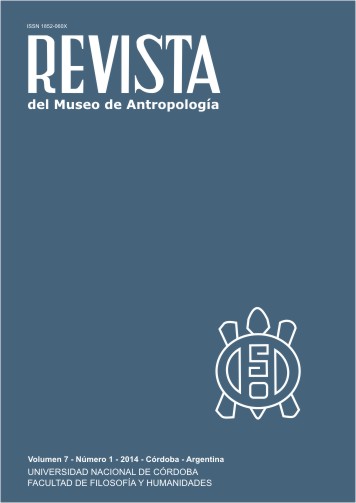Alcohol consumption practices at a pampa´s general store (Casa de Negocios) during the end of the nineteenth century. Analysis of lead capsules and glass fragments (Posta el Caldén, department of Realicó, La Pampa, Argentina)
DOI:
https://doi.org/10.31048/1852.4826.v7.n1.9094Keywords:
alcoholic beverages, XIX century, La PampaAbstract
Within the framework of Ubacyt F 095 project that has as part of its aims to study the settlement of the northern province of La Pampa after the military campaigns of the late nineteenth century. We present the analysis of lead seals and fragments vitreous from the site Posta Caldén (Section I, Dept A, lot 24). This site is a crossroad post and a grocery store in the late nineteenth century. It belonged to a line of posts between the cities of Victorica (Province of La Pampa) and General Villegas (Province of Buenos Aires). Morphological and functional analysis be made and metallographic by light microscopy (LM) and scanning electron (SEM) and chemical spectroscopy using energy dispersive X-ray (EDS) of the parts under study. The objective was to determine types of alcoholic beverages and their origins. Various types and brands of ethylic drinks were identified. It was determined that the material was making seals lead coated tin typical preparation technique called roll bonding. This information will be useful when studying the social practices of these new immigrant groups in combination with the written sources and oral historyDownloads
References
Askeland, D. 2004. Ciencia e Ingeniería de los Materiales. Thompson. México.
Bachelard, G. 2000. La poética del espacio. Fondo Económico de Cultura.
Ciarlo, N. María C. Lucchetta y H. De Rosa. 2013. “Análisis metalográficos y químico de un conjunto de artefactos recuperado del naufragio Triunfante (1756-1795), Golfo de Rosas (Cataluña, España)”. En prensa.
Dorfman, A. 1970. Historia de la industria argentina. Hyspamerica. Buenos Aires.
Exner, H. E. y S. Weinbruch. 2004. Scanning Electron Microscopy.ASM Handbook: Metallography and Microstructures, vol. 9, pp. 355-367. ASM International, EE.UU.
Flewitt, P. E. J. y R. K. Wild. 1994. Physical Methods for Materials Characterization. Institute of Physics Publishing, Ltd., Londres
Giberti, H. 1986. Historia económica de la ganadería argentina. Hyspamérica, Buenos Aires.
Gonzalez, L. 2004. Bronces sin nombre. La metalurgia prehispánica del noroeste argentino. Fundación Ceppa. Buenos Aires. http://www.marcasconhistoria.com.ar/detalle_bieckert.php (Última consulta: 26/07/2013). http://www.branca.com.ar (Última consulta: 14/03/2010) www.marcasconhistoria.com.ar/detalle_bieckert.php (Última consulta: 26/07/2013). www.quilmes.com.ar/historia (Última consulta: 26/07/2013). http://hesperidina.blogspot.com.ar (Última consulta: 26/07/2013).
Laclau, E. 1975. El régimen oligárquico. Materiales para el estudio de la realidad argentina (hasta 1930). Amorrortu,Buenos Aires.
Landa, C. 2010. Análisis de artefactos provenientes del Fortín Otamendi (1858-1869) vinculados a las prácticas alimenticias. 3er. Encuentro de Jóvenes Investigadores en Ciencia y Tecnología de Materiales. Concepción del Uruguay, 12-13 de agosto. Publicación en CD. Universidad Tecnológica Nacional, Delegación Regional de Concepción del Uruguay.
Lindon, A. 2007. Los imaginarios urbanos y el constructivismo geográfico: los hologramas espaciales. Revista Eure. Vol. 23. Nº99.
Pontificia Universidad Católica de Chile, Santiago de Chile. pp. 31-46.
Marchoff, M. s/f. La cocina por asalto. Ciencia, cocina y género en la transición al siglo XIX. http://www.unpocodehistoria.com/monografias/la-cocina-porasalto. php (Última consulta: 11/12/2010).
Mayan, M. 2001. Una introducción a los métodos cualitativos. QualInstitute Press. Alberta, Canadá
Montanari, E., C. Landa y V. Pineau. 2013. El Caldén. Pulpería y Posta de Caminos. Norte de La Pampa (Fines del siglo XIX). Primera Aproximación. Revista del Museo de La Plata, Secciòn Antropologìa 13 (87): 395-404.
Pineau V.2010 Esto no es soplar y hacer botellas. Precisando la cronología de un sitio ranquel a través de los fragmentos vítreos. En: De ranqueles, militares y religiosos en el Mamül Mapu. Enfoque Arqueológico y Etnohistórico.Tapia A. (ed).Publicación digital. Ediciones de la Facultad de Filosofía y Letras. Universidad de Buenos Aires. Pp. 5-109.
Scobbie, J. 1968. Revolución en las pampas. La historia social del trigo argentino 1860-1910. Solar Hachette, Buenos Aires.
Downloads
Published
Issue
Section
License
Those authors who have publications with this Journalaccept the following terms:
a. Authors will retain their copyrights and guarantee the journal the right of first publication of their work, which will be simultaneously subject to the Creative Commons Attribution License (Licencia de reconocimiento de Creative Commons) that allows third parties to share the work as long as its author and his first publication in this journal.
b. Authors may adopt other non-exclusive licensing agreements for the distribution of the version of the published work (eg, deposit it in an institutional electronic file or publish it in a monographic volume) provided that the initial publication in this journal is indicated.
c. Authors are allowed and recommended to disseminate their work on the Internet (eg in institutional telematic archives or on their website) before and during the submission process, which can lead to interesting exchanges and increase citations of the published work. (See The Effect of Open Access - El efecto del acceso abierto)












